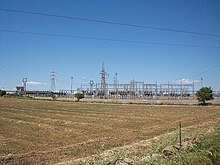| Malta–Sicily interconnector | |
|---|---|
 Ragusa's substation. Ragusa's substation. | |
| Location | |
| Country | Malta Italy |
| General direction | north-south-north |
| From | Magħtab, Naxxar in Malta |
| Passes through | Malta Channel |
| To | Ragusa in Sicily, Italy |
| Ownership information | |
| Owner | Enemalta |
| Construction information | |
| Manufacturer of conductor/cable | Nexans |
| Cable layer | C/S Nexans Skagerrak |
| Construction cost | €182 million |
| Commissioned | 2015 |
| Technical information | |
| Type | Submarine cable underground cable |
| Type of current | HVAC |
| Total length | 120 km (75 mi) |
| Power rating | 200 MW |
| AC voltage | 220 kV |
The Malta–Sicily interconnector is the submarine power cable which connects the power grid of Malta with the Italian Transmission Network managed by Terna, which is part of the European grid. It was constructed in 2014-2015, and supplies roughly 1⁄4 of Malta's electrical power.
Technical characteristics
The 95-kilometre (59 mi) long subsea cable starts at Magħtab, Qalet Marku in Malta and it runs to Marina di Ragusa in Sicily, Italy. From there it is connected to the Ragusa substation, which is of the Italian TSO Terna, via a 25 kilometres (16 mi) underground cable.
The cable and 132/220 kV substation in Malta is provided by Nexans. The cable has capacity of 200 MW and it uses 220 kV high voltage alternating current. The interconnector is operated by Enemalta, the Maltese power company. In the 2014 the cable was laid in the sea by the ship C/S Nexans Skagerrak of the Company Nexans. The interconnector became operational in March 2015. The project cost €182 million.
Economic impact
The cable allows Malta to exchange electricity with the Italian power market, i.e. the island can both import and export electricity from Italy through the interconnector. The creation of this subsea cable ended Malta's previous electricity's isolation and diversified its mix of energy sources. In February 2015, European Commission underlined that Malta's interconnection level would go from 0% to approximately 35% with the new interconnector.
Problems
In December 2019 power outages in Malta were being caused by a failure of the interconnector cable having been damaged by a ship's anchor. In 2019 the interconnector supplied 23.1% of generated power.
Sites
| Site | Coordinates |
|---|---|
| Substation of Ragusa | 36°52′47″N 14°40′53″E / 36.87972°N 14.68139°E / 36.87972; 14.68139 (Stazione elettrica di Ragusa) |
| Italian submarinecable terminal, Marina di Ragusa | 36°46′48″N 14°34′10″E / 36.78000°N 14.56944°E / 36.78000; 14.56944 (Camera di giunzione di Marina di Ragusa) |
| Maltese submarinecable terminal, Qalet Marku | 35°56′36″N 14°26′59″E / 35.94333°N 14.44972°E / 35.94333; 14.44972 (Qalet Marku) |
| Substation in Magħtab (in project) | 35°56′19″N 14°26′17″E / 35.93861°N 14.43806°E / 35.93861; 14.43806 (Stazione elettrica di Maghtab (in progetto)) |

See also
- Energy in Malta
- Energy in Italy
- List of high voltage underground and submarine cables
- Pylons of Messina – Historic high-voltage towers in Italy
References
- Sansone, Kurt (2010-12-15). "Malta signs €182 million interconnector contract". Times of Malta. Retrieved 2012-02-12.
- ^ "Nexans wins contract for the Malta to Sicily power-interconnector project" (Press release). Nexans. 2010-12-15. Retrieved 2012-02-12.
- Micallef, Mark (2011-11-20). "Power setback as energy link to Sicily is delayed". Times of Malta. Retrieved 2012-02-12.
- Debono, James (2009-11-22). "Sicily cable 'essential' to close down Marsa power station". Malta Today. Retrieved 2012-02-12.
- "Nexans Norway to lay Malta-Sicily undersea power cable". Reuters. 2010-12-14. Archived from the original on March 7, 2016. Retrieved 2012-02-12.
- COMMUNICATION FROM THE COMMISSION TO THE EUROPEAN PARLIAMENT AND THE COUNCIL - Achieving the 10% electricity interconnection target - Making Europe's electricity grid fit for 2020. Brussels, 25.2.2015 COM(2015) 82 final
- "How could a ship's anchor take out a key source of Malta's power?" (Press release). Times of Malta. 2020-01-01. Retrieved 2020-01-01.